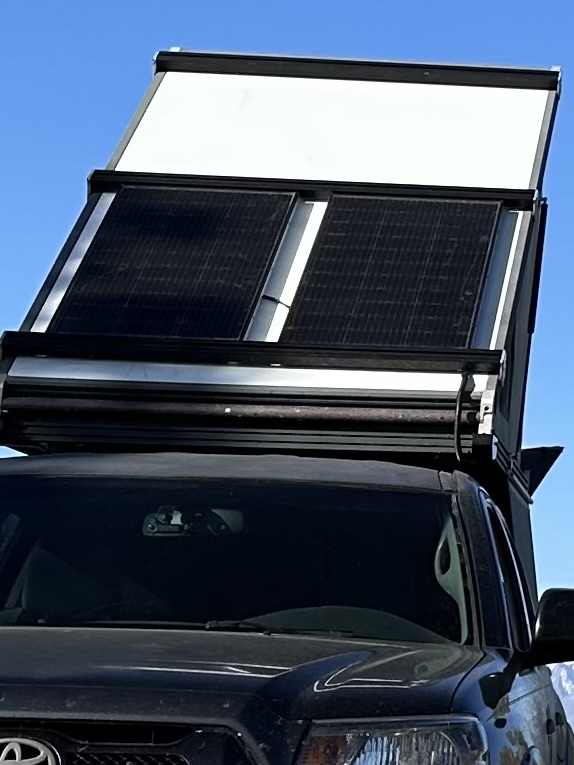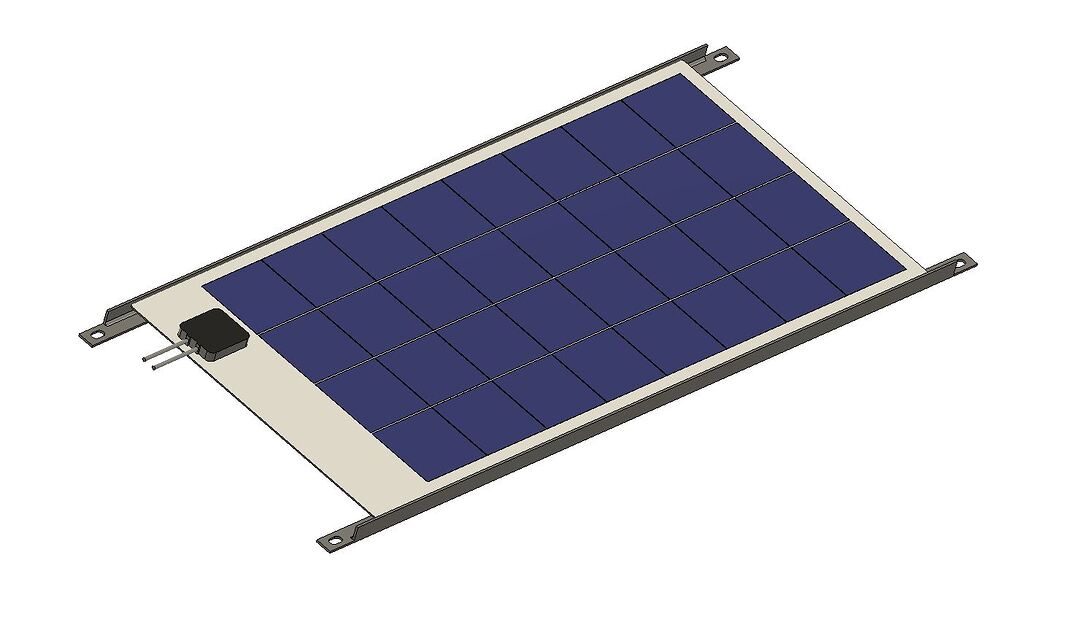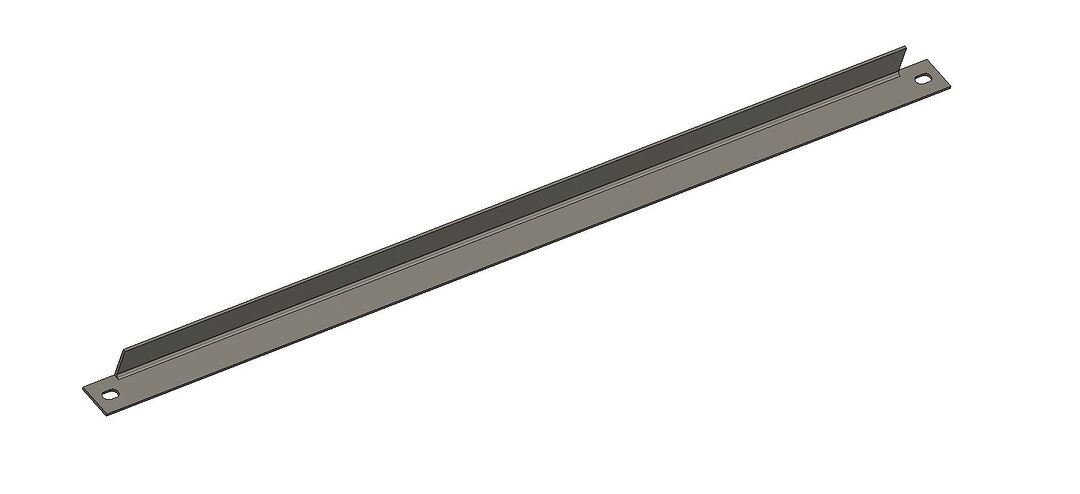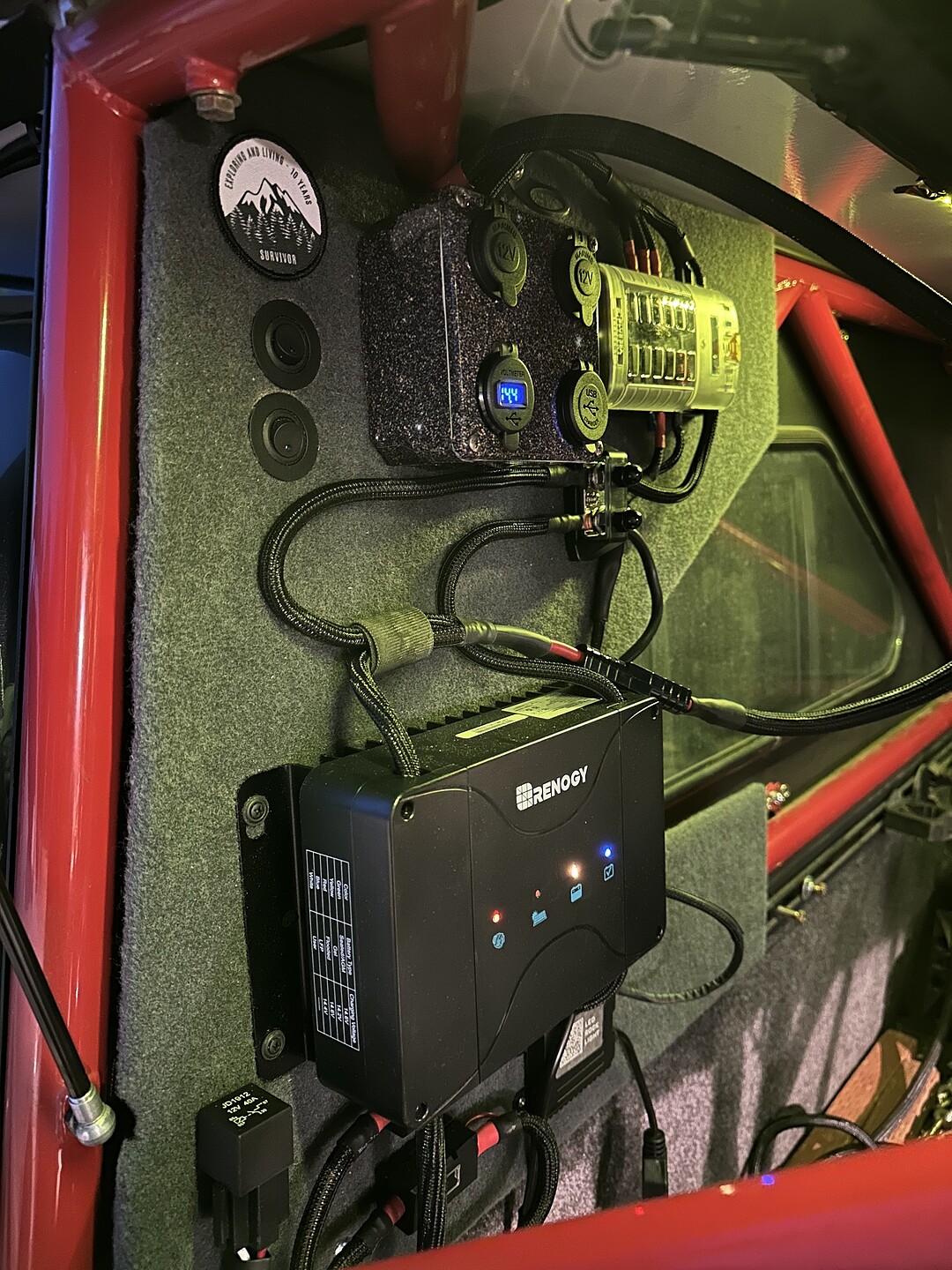Yes! I wish that there were some longer solar trays to accommodate panels in this “portrait orientation.” The GFC trays only allow “landscape” so you need 3 (heavy) beef bars in close proximity to accomodate 2 panels.
I kind of regret buying the beef bars. the 8020 solutions folks have show are lighter weight and more customizable.
I make some solar mounts that came about to solve the landscape only issue with the solar trays. They are pretty easy to fab up yourself if you have the tools/time or I sell a pack of 4
https://jedf.us/#!/SolarMount-for-Beef-Bars/p/641231769/category=113909263
Here’s a really simple-to-fabricate idea.
I don’t think everyone knows that there’s another T-slot on the UNDERside of the Beef Bars. I use the underside track for my solar setup.
So what you’d do is take a piece of aluminum angle or angle iron and cut the edges as pictured with a hacksaw or angle grinder. Then drill an oversize hole or make a slot to match up with the Beef Bar underslide T-slot. You make four of these for two panels. You can mount the panels to the angle with screws, clips, VHB, sikaflex, really anything.
You’ll need two screws and two T-nuts per bar, so 8 screws/8 T-nuts.
The best thing about using the hidden slot is that the top of the Beef Bars sits a little bit “proud” of your panels, so you can still store stuff on top and use the bars as intended.
Awesome solution @Vice_Chief
I’m collecting parts currently for my solar and this was my plan because it seemed like the easiest way to space the solar panel from the beef rack so I can still run a Thule alpine box in the winters without removing the solar panel.
Thank you so much! So simple!! Exactly what i need.
Thank you!
Just a heads up so that nobody makes the same dangerous mistake as me.
You really do need to take special attention the the t-nut in the bottom track.
The GFC Beef Rack Track Studs are NOT compatible with the bottom track (only compatible with the top track).
They seem like they tighten up and fit; but the do not. The product description is currently very misleading. I have notified GFC; hopefully before anybody gets hurt or worse by a solar panel flying up the freeway!
Not the happiest camper at the moment. I’ll post pics when the project is complete.
Sorry to hear that. I didn’t know Beef Rack Track Studs were a thing - on my setup, I used T-nuts and bolts.
Hey guys,
I have been taking a deep dive into how to get a solar set up for my GFC, and I come here looking for advice. I am a total beginner when it comes to this. Two days ago if you asked me what an inverter was I would have no idea. Initially I was going to buy a Goal Zero set up for the simplicity but after doing some reading I’m thinking building my system from scratch is going to cater to my needs better.
General Use
My GFC is used for MTB/camping trips 1-2 weeks duration (some overnights at local bike parks etc). Generally I am in deserts or mountainous terrain. MTBing means I am parking my car at a trailhead for most of the day and then driving to a camp spot at the end of the day (rinse and repeat for 1-2 weeks). For this reason I want my panels to be fixed to my roof so they can collect while I’m out riding. I am trying to avoid wiring this system up to my alternator and hoping to utilize the 120 V plug in the bed of my Tacoma to run the fridge while I’m driving longer distances (and hopefully let the battery recharge via solar). Would this work?
Power Consumption: Running a 75 qt Dometic Dual Zone Fridge 24/7 for 1-2 weeks at a time. Additionally I will be charging a phone once per day, running some LED lights, and possibly charging something like a GoPro. I’m estimating 500 watt hrs (at worst assumption - hot desert day) per 24 period for the fridge consumption. I am going to be designing some sort of insulation/box for the battery/fridge to help out in the hotter environments. Initially I was planning on using my old Yeti cooler for beverages but I think as long as I can avoid ambient temp liquids I can use chilled beverages to my advantage.
Design Consideration:. Based on the advice from someone who has already gone through this process I am considering “overbuilding” my inverter and solar charge controller to maintain some flexibility with my electrical demands. I have a 2000W inverter and 30 amp charge controller selected right now, which is overkill for my initial design, but I don’t want to buy a 1000 W inverter now just to buy a 2000 W inverter in a year or two if my electrical demands increase.
Below is a list of some products I have been considering. I am not particularly tied to any brand and this is just an example of something I have come up with.
Any thoughts? Again I’m a total beginner at this so any words of wisdom or any advice is appreciated. The builds in here are really inspiring!
you don’t wnana run the frdige via 120v
I’m in SoCal ( very hot rn). My dometic CFx35 has zero problems even on the hottest days, but my goal zero yeti overheats every day. Only advice I can give is to avoid products that can’t deal with the heat.
This is what I have, and I have been pretty happy. Opinions are my own.
A Redarc BCDC1225D charger, 100aH Lithium battery (cheap Amazon unit) and 2 100w solar panels in my Tacoma. I only added a monitoring system to it last week so wasn’t able to monitor the system.
The BCDC will take power from the alternator or solar (whichever is best) and keep the Li battery charged. That battery runs my cooler and various chargers. I run my cooler off 12v as you waste a lot of energy converting to 120ac and then back to 12v.
Typically, when out I drive everyday so the Li battery stays charged from alternator. Recently I was camping for a few days and the first 2 days I did not allow my panels to get any sun, and the battery drew down, now with a monitor I will be able to judge better and will run some tests this next week to determine if the solar watts I have will keep the Li battery charged.
I am also in So Cal., this system has been operating for over 2 years now with no issues and has been all over the West.
BR
Curious what issue you had. I used the GFC track studs on the bottom of my beef bars holding on a pair of 100w panels and have not had a problem. I did make sure they were fully seated before tightening and have over 5,000 miles (with about 1,000 of that off road and 2,500+ at freeway speeds of 70-80mph) and they’ve been holding fine.

On the charge side, I’m using a Renogy 50a mppt controller.
Hey thanks! This is more along the lines of what I’m doing now. I ditched the AC inverter as I don’t think I’ll need one for now. I’m definitely sold on adding the DC-DC alternator setup in addition to the PV. I’m also adding a 12v Seaflo water pump that will draw from a 10 gal reservoir (dishes, wash bike, rinse head, etc).
Spent the day yesterday drafting a few “at scale” bed designs for my cabinets and thinking how all of this is going to fit together. Based on the physical dimensions of my fridge and where I want to put it, I had to scale down to a 45 CFX3 (slightly smaller footprint than IceCo, but taller) from the 75 qt dual zone. The 40 L National Luna is the PERFECT dimensions for my build, but of course it’s the $1,400 fridge.
Taking a crash course on Youtube University now on how to build cabinets out of 80/20 extrusions. Will be ordering my pump, reservoir, fridge, and solar electronics soon as all the dimensions of my cabinets will be built around this.
Don’t miss “the aluminum carpenter” for lots of slick tricks.
Did you stop making these?
Yes I did stop making them due to very little demand.
If this response was to your version of the beef bars. Bring them back! ![]()
Good to know…




